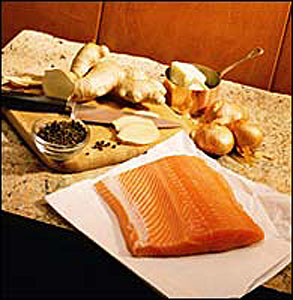All sorts of salmon.(salmon varieties)
by Julia Malloy
From Better Homes and Gardens

All sorts of salmon.(salmon varieties)
Your market may offer up to a half-dozen kinds of salmon. often, you can use different kinds interchangeably, but sometimes your recipe, your budget, or the occasion may point to using a certain kind.
SHOPPING FOR SALMON
The salmon in supermarkets today tends to be uniform in size, color, and flavor because much of it is raised on fish farms. Some of the ocean-caught salmon still comes from U.S. shores, but a growing number are imported from such countries as Chile.
At the fish counter, you'll see that salmon meat can range in color from the deep orange of sockeye to the fight blush of pink. Its flavor can vary from mild to rich, with farm-raised fish having a milder taste than ocean-caught salmon.
Just as salmon vary in color and flavor, they also vary in price. Chinook tends to be the most expensive, making it a splurge food. Pink usually costs the least. You can buy salmon whole, in fillets or steaks, and canned.
SALMON YOU MAY SEE
Atlantic: This variety of salmon is primarily farmed. The flesh can be pink to red or orange. It is somewhat higher in oil than other types of salmon, which makes it a good
Chinook or King: The largest and most expensive salmon from the Pacific Ocean, chinook has soft flesh that can range from deep pinkish-orange to almost white. The oil-rich flesh broils and grills well without basting.
Chum, Keta, or Silverbright: This salmon can range in color from red to light pink. Chum has a slightly coarser texture and less fat than other salmon, so it's best steamed or poached.
Coho or Silver. Often called silver salmon because of its silver-skinned belly and sides, coho's flesh can range from pink to orange-red in color. Because farm-raised cohos can be smaller than their ocean-swimming cousins (as small as 10 ounces), they're an excellent choice for individual servings of drawn or dressed fish.
Pacific: This term can refer to any of the five salmon species found on the Pacific coast: chinook, sockeye, coho, pink, or chum salmon. If you see salmon labeled as Pacific, find out what kind it really is so you'll know how to best prepare it.
Pink: As its name suggests, the flesh of this salmon is fight pink. It's the smallest and most abundant variety, and also the least expensive. Its peak season is short, but canning makes it available year-round. Serve pink salmon in casseroles, soups, and sandwiches.
Sockeye Blueback, or Red: Although it's primarily sold canned, this salmon can be found fresh during the summer months. The deep red color, firm flesh, and moderate fat content make sockeye salmon an excellent choice for baking. Serve it warm or chilled. Break it into chunks for salads, pastas, and appetizer toppings.
COPYRIGHT 1995 Meredith Corporation
COPYRIGHT 2000 Gale Group
|